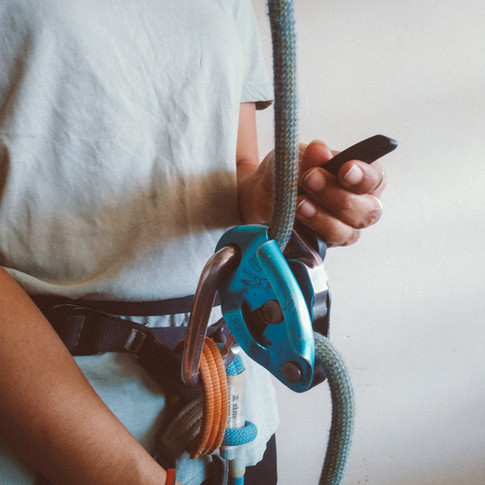Homo sapiens have been climbing trees for fruits, rock walls to hide in caves, overhanging steep rock faces to hunt for honey, & crossing mountains to find distant lands for eternity. Climbing is inherently imbibed in our genes, and for a long long time we have never used any equipment or gear to climb, essentially we are free soloists. But now as a civilization, we don't need to climb for honey or fruits, or hide in caves from animals at night; so we have started climbing for its fun & thrill or as a challenge.
I can’t talk for everyone but I don't want to fall and die while enjoying an adventure sport and neither did the slightly whacked-out climbers in the last 50 years. So they devised climbing equipment from the technology we have had. Most of the climbing gear is designed to protect us in the event of a fall while some aid us in climbing rocks. All climbing gear is rated to a certain force they can take before they break, not to worry they are engineered to take almost four times the load that they are designed to be used for. I might write a separate blog about it.
In this blog, I am going to cover climbing gears that are widely used in climbing and how can you source them. There is no way a blog can teach you how to use them, and in no way I am teaching you that through this blog. Teaching should only be done by an experienced climber or instructor in person. If you haven't read my blog on the different styles of climbing it would be better to read that first.
But for now, let's start with listing and describing gear that keeps you alive (a.k.a safe) on the rock.
1. Helmet
This is, without doubt, the most underrated gear in rock climbing. It's hardly worn by the pro-climbers you see on the internet and NEVER by the wanna be pro-climbers. There are small rocks that are just hanging around those bigger rocks waiting for their turn to fall. Sometimes an animal or a climber could do those small rocks a favour, or sometimes the climber can drop some equipment on his/her own belayer and knock them unconscious, or worst-case scenario, the climber can have an upside-down swinging fall and smack their head on the rock face. There are many nasty situations you can get into and wearing a helmet can keep that jelly noodles safe from coming out of your head. You can certainly only excuse the helmet when you are bouldering in a safe environment but remember - it's okay to be the only climber wearing a helmet at the crag, climbing or not. When buying a helmet, ensure you buy one you are comfortable in, because if you are not then chances are you will never wear it.
2. Seat harness
When climbing high with rope (not bouldering), you will have to attach yourself to various gear like rope, belay device, rappelling devices etc. And sometimes you will experience sudden pulling forces on those gears and obviously on you as well. So a harness is what makes experiencing those jerks more comfortable.
It spreads those forces evenly across your thighs, hips, back and torso by creating a tie in point on your body. Try imagining yourself tied by a rope around your waist and you fall on it? The loop will rub against your waist and will probably end up around your chest and armpits. Let alone the discomfort, it will be hurtful, hence the need for a harness.
There are beginner harnesses that have only one tie loop. This does limit their use. You see it in climbing gyms or is used by participants in commercial rock climbing activities. But if you are buying a harness for personal use then buying the harness with separate tie-loops and belay loop is a no brainer. A must-have in your personal gear, right after your climbing shoes. When buying a harness I would see how comfortable I feel in it. If there is no way to hang in it at the shop, I would recommend doing some weird side squats or some hip stretches to find out.
P.S- Thicker padding at the waist loop doesn't mean it will provide more comfort so shop wisely.
3. Climbing rope
The lives of climbers hang by a thread and that thread is called a “climbing” rope. These climbing ropes are really good under stress, (pun intended) and are strong enough to lift a mid-sized SUV car. So when the climber falls on the climbing rope it stretches thus giving the climber a softer jerk & making him bounce up just a little. This particular characteristic of the climbing rope it's also called dynamic rope.
It's best to experience a fall and feel the stretch in the rope, but let me try to explain by giving you an example >> A sleepy driver sees a child 10 meters from the bus, the driver applies the brake and goes from 100kmph to a halt. This sudden braking translates a lot of force on the not so happy passengers who have been lifted up and banged up against the seats in front. If the driver had seen the child from far and slowed the bus gradually, then it would have translated manageable forces on the passengers and kept them in their seats. This slow breaking is what the dynamic climbing rope does when a climber falls on it and why it is important to use one.
Dynamic ropes are of different kinds depending on their thickness and strength. They are categorized into half rope, twin rope, single rope. They all are made with Nylon (poly amid). You should select your rope depending on where you climb and the type of climbing, but a single rope is what you will need most of the time in India. The ‘single rope’ has a rope diameter of 9 - 10.5 mm.
Usually, the thicker the rope the more abrasive resistant it is. But it also adds more friction while passing through the rappel/belay devices, which sometimes is not a favourable thing. Personally, I like anything between 9.2 to 9.8 mm. Lengthwise they range from 45 meter - 80 meter long. I think 60 meters is the sweet spot as finding a single pitch climb more than 30 meter in India is very rare. The rope is also the heaviest climbing equipment, so carrying and travelling with an 80-meter rope is just a hassle. Also while buying make sure the rope has a centre mark with ink or with braiding.
There are Semi-Static ropes that don't stretch as much and are used by climbers for other purposes like rappelling, anchor building, developing/clean rock faces but they should not be used for climbing. With experience, you can tell the difference between a static and a dynamic rope by how soft it is, or the way it bends.
As a beginner, you can always borrow a rope from a climber friend or a more experienced climber, while you can save up and buy a nice one later.

4. Personal Anchor System
Abbreviated as PAS, it is basically a Flat Nylon webbing or a piece of dynamic rope that is attached to the tie loops of the harness and has a locking carabiner on the other end. It's used to ‘self anchor’ yourself to a hardpoint on the route i.e. bolted hanger, protection placed in the crack, top anchors etc. If you like to climb high with ropes, then this makes a lot of chores on the vertical wall safer. As with all climbing gear make sure to learn how to use one from an expert. I would recommend buying one along with the harness.

5. Carabiners
You might have seen youngsters having carabiners clipped to their denims or backpacks, they probably wanted to cool as climbers. (wink, again) If you by any chance were one of those youngsters then now is the time to justify owning one for the real reason! A carabiner is one of the most robust climbing gear you will own. They were used to be made from steel but the modern ones are made from a much lighter aluminium alloy. Essentially, they help in creating a link between two pieces of gear for example- a belay device and a harness, or PAS and anchor, used in a quick draw and many more. They can take up forces upwards of 22 KN when loaded correctly (2200 kg dead-weight). Reading what's written on the carabiner can be quite interesting as it shows how much force it can take when loaded in different directions. Broadly they can be divided into two types- locking and non-locking. The locking ones will have the gate lockable i.e. they won’t open accidentally when locked and non-locking ones (plain gate) don’t have such locks. A screwable locking gate is the most commonly found type and is called a ‘screw gate’.
They come in a variety of different shapes and sizes designed for specific use. Recently most of the manufacturers are doing away with the notch where the gate sits closed, as it tends to get stuck particularly when taking it off a hanger. It's called the ‘keylock’ feature.
Buying an ‘offset D’ shaped locking carabiner with a keylock feature is best to begin with, which can be used for almost all purposes.

6. Quickdraws
They are simply two non-locking carabiners connected by a nylon webbing. Mostly used in lead climbing, they help in attaching one carabiner at the protection and passing the rope through the other. Again there are types in this too and are specifically designed for different types of climbing. Broadly you can categorize them by their gate style -wire gate and solid gate. There is hardly any advantage of one over the other, except wire gates tend to save some weight on the gate with high tensile steel wire and not solid aluminium. It's a preference thing.
Using the quickdraws and clipping the rope correctly is very important to make sure you stay alive when you fall on them. So please make sure you are taught by an expert.
I won't recommend owning a set of quickdraws until you get into leading full time, but when you do, buy the ones with the keylock feature which I repent not doing.

7. Belay device/rappel device
This small piece of equipment requires skill to wield, which comes with a lot of experience and/or by learning from the mistakes of others, as personally, you don't want to deck your own climber or yourself while rappelling. Improper use of a belay device can literally make or break your climber.
It's safe to say that you can rappel using belay devices and vice versa. (I really can't think of any new age belay device on which you can't rappel on.)
In short, the job of this device is to control the passing of rope through it, and break when the climber falls. There are assisted braking belay devices in the market like the Petzl GriGri, the Beal Birdie etc. but I strongly suggest you should always learn belaying with a tuber style belay device (a.k.a ATC). There is a lot more I can tell you about belay devices but I don't want this blog to get super long. You would know when it's time to buy a device, until then it's okay to borrow, as no climber can belay without it. Oh well, you can, but belay devices are super recommended.
8. Cams, Choke nuts, Hex nuts
They are the metallic cyborg looking gear that climbers put into cracks as protection and pass the rope through them. So if the climber happens to fall one meter above the previous placement, then on his way down he can hope this gear will not get pulled out and he stops falling a meter or two only. Primarily used in traditional climbing style (aka trad-climbing), but they have many uses on any natural vertical. They are definitely not something you should get as a beginner. This gear can get expensive especially the cams aka friends aka SLCDs. Image credit: rockandice

9. Crashpad
You might have seen skinny people carrying huge cuboids on their backs disappearing in the remote outdoors, that breed is called boulderers and their crash pad has got their back.
The purpose of the crash pad is to cushion those falls from a height of up to 6 meters, beyond which it is sheer stupidity to climb without ropes.
As bouldering involves a lot of trying and falling on the same moves and boulders, again and again, the crash pad gets a lot of importance in a boulderer’s life. If you have enjoyed bouldering and want to pursue it further, this 1 x 1.5 x 0.1 meter block of foam is the only thing you will want to buy except rock climbing shoes of course. Also owning one will increase your chances of getting invited to climbing trips by two folds.
Now to the climbing equipment that gives you an enormous advantage on the rock while climbing it, compared to what the prehistoric man had (aka nothing).
10. Rock climbing shoes a.k.a P.A shoes
Can you hop around like those mountain goats on a steep vertical? Probably not. But what if I put their hooves on you, you will definitely get better at climbing, won't you? That's what Pierre Allain might have thought when he made the first modern rock climbing-specific shoes in the 1950s.
There are few things about how a climbing shoe helps you climb better.
It has an outer sole of a well-engineered sticky rubber.
The construction of the shoes allows it to take your entire body weight on your toes.
The fit of the shoe gets your toes pressed against the thin lining of the toe box, making stepping on micro footholds easier.
And now addressing the elephant in the room, yes these shoes are going to be a little pain due to their tight fit, initially a bit more, but as soon as the joy of climbing overcomes the sadness of pain, you will bow and thank Pierre Allain for his invention.
Now for the trickiest part, buying the right size of climbing shoes. So first make sure the seller is a climber or you to the shop (not online shop) there with a climber friend, otherwise, you most definitely are gonna waste your money buying an oversized pair as I did. If you think you are going to get hooked to climbing, I would recommend buying an intermedia grade shoe. I will write another blog to just address this and the size and fitting.
Shoes should be one of the first climbing gear you buy. You will be lucky to get a second-hand pair as a beginner as you will most definitely eat through the rubber pretty soon with your immaculate footwork.
11. Chalk and chalk bag
Magnesium Bi Carbonate in the powdered form is what makes those sweaty hands of weight lifters dry and improves grip. Same with climbers. This powder has the property of absorbing water molecules and provide a better grip on the rock. When you climb, you will realise how frequently you need to reapply. It is easily available online or in any big sports stores. Though some manufactures have some special mix that they claim better results than the pure MgCO3, I find it gimmicky. There are these pouches that help store and apply chalk called chalk bags. (you would never guess that, would you? Okay, I will stop trying to be funny). So buy a chalk bag or perhaps your mom can stitch one for you, buy some MgCO3 and start climbing. It's a nice thing to own - a personal chalk bag with some chunky chalk. Check out Dino Chalk bags's Instagram page, they make some funky chalk bags from recycled cloth.
12. Brush
You want that chalk on your hands not on those rocks, old stale oily gunky slither of chalk can degrade the rock and spoil the experience for the next climber, so carrying a brush in your chalk bag and cleaning the holds after you finish is ideal. Rocks can be sensitive. I won this brush at a climbing festival from Boulderbox climbing gym .

So that sums up my list of climbing gear beginners should know about. Now, let's talk about how you can go about acquiring the above-mentioned equipment.
As rock climbing is still a very niche sport in India and most of the countries in the world. Walking into a rock climbing-specific store filled with climbing equipment is a wet dream. But with enough know-how around India and aarrmh....(the US of A) you can pretty much acquire all the good quality gear you need. Here are some options for the Indian folk.
Decathlon stores have been a boon to me, almost all the gear I started with is from their climbing brand Simond, their gear is UIAA rated and is of pretty good quality. Gipfel is an Indian brand that makes solid climbing gear, some of their gear is UIAA rated and some is CE or EN. I like the quality and size of their crashpads.
Mostly all indoor climbing gyms will have some gear that they sell.
If you live in a big city you will definitely have adventure store like Adventure18 (New Delhi), Stepin adventure (Pune), Cliff climber (Dehradun) which sell climbing gear.
Your US residing friends or family will come in handy as they can carry some climbing equipment on their visits to your country. US stores have discounts all the time, especially on the famous Black Friday.
But the best thing to do is to ask your climber friends to recommend gear and where to buy it. They will have the best idea of availability around you, and if they like you as a climber they might just consider donating their old but useful climbing gear. I was given a nice pair of La Sportiva Katanas by a German climber Mathhias in Hampi. And I have returned the favour many times.
Some of the climbing gear probably will last your entire life while some have to be replaced with visible wear or just with age. All such details about inspecting wear and replacing gear require its own blog. Also, all climbing gear that takes load must have EN or CE or UIAA rating. These are all safety standards. Look out for these tags before buying.
Stay safe and see you soon at the crag!





















You're on the right track now! Very good article thnx for sharing energetic information. I appreciate u.U working more to promote the website.
keep it, blog Upload on regularly. I read the blog on upcoming. Go and Watch the Latest Episode of Kurulus Osman Season 3 in Urdu. Only on our youtube channel.
Manchester City Jersey are casual attire. ... I don't think you're going to get hurt, and you sure aren't
having to perform much more than showing off your chugging prowess, so don't tuck your jersey
in unless you want to be the biggest dork in the room.